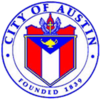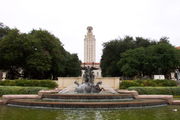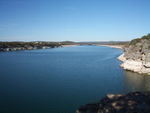Austin, Texas
| City of Austin | |||
|---|---|---|---|
| — City — | |||
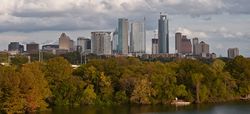 |
|||
|
|||
| Nickname(s): Live Music Capital of the World,[1] The ATX,[2] City of the Violet Crown,[3] The Capital City | |||
 |
|||
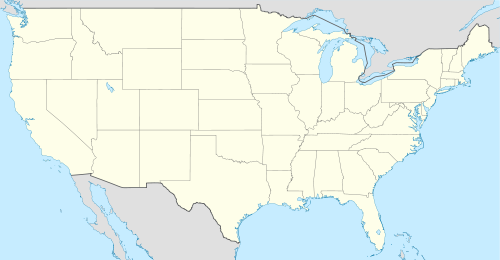 City of Austin
|
|||
| Coordinates: | |||
| Country | United States of America | ||
| State | Texas | ||
| County | Travis Williamson Hays |
||
| Settled | 1835 | ||
| Incorporated | December 27, 1839 | ||
| Government | |||
| - Type | Council–manager | ||
| - Mayor | Lee Leffingwell (D) | ||
| - City Manager | Marc Ott | ||
| Area | |||
| - City | 296.2 sq mi (767.28 km2) | ||
| - Land | 251.5 sq mi (651.4 km2) | ||
| - Water | 6.9 sq mi (17.9 km2) | ||
| - Metro | 4,285.7 sq mi (11,099.91 km2) | ||
| Elevation | 489 ft (149 m) | ||
| Population (2008)[4] | |||
| - City | 786,382 (15th) | ||
| - Density | 3,126.6/sq mi (1,207.2/km2) | ||
| - Metro | 1,705,075 | ||
| - Demonym | Austinite | ||
| Time zone | CST (UTC-6) | ||
| - Summer (DST) | CDT (UTC-5) | ||
| ZIP code | 78701-78705, 78708-78739, 78741-78742, 78744-78769 | ||
| Area code(s) | 512 | ||
| FIPS code | 48-05000[5] | ||
| GNIS feature ID | 1384879[6] | ||
| Website | www.ci.austin.tx.us | ||
Austin is the capital of the U.S. state of Texas and the seat of Travis County. Located in Central Texas on the eastern edge of the American Southwest,[7] it is the fourth-largest city in Texas and the 15th-largest in the United States.[8] It was the third-fastest-growing large city in the nation from 2000 to 2006.[9] Austin has a population of 786,382 (2009 U.S. Census estimate).[4] The city is the cultural and economic center of the Austin–Round Rock metropolitan area, with a population of 1,705,075 (July 2009 U.S. Census estimate)[10], making it the 35th-largest metropolitan area in the United States.
The area was settled in the 1830s on the banks of the Colorado River by pioneers who named the village Waterloo.[11] In 1839, Waterloo was chosen to become the capital of the newly independent Republic of Texas. The city was renamed after Stephen F. Austin, known as the father of Texas.[11] The city grew throughout the 19th century and became a center for government and education with the construction of the Texas State Capitol and the University of Texas.[12] After a lull in growth from the Great Depression, Austin resumed its development into a major city in the 1980s and emerged as a center for technology and business.[11] Today, the Greater Austin area is home to many companies, high-tech and otherwise, including the headquarters of four Fortune 500 corporations: Whole Foods Market, Freescale Semiconductor, Forestar Group, and Dell.[13] On March 12, 2010, Facebook accepted a grant to build a downtown office that could bring as many as 200 jobs to the city.[14]
Residents of Austin are known as "Austinites" and include a diverse mix of university professors, students, politicians, musicians, state employees, high-tech workers, blue-collar workers, and white-collar workers.[15] The main campus of the University of Texas is located in Austin. The city is home to development centers for many technology corporations and in the high-tech 1990's adopted the nickname "Silicon Hills". However, the current official slogan promotes Austin as "The Live Music Capital of the World", a reference to the many musicians and live music venues within the area.[1][2] In recent years, many Austinites have also adopted the unofficial slogan "Keep Austin Weird"; this refers partly to the eclectic and liberal lifestyle of many Austin residents but is also the slogan for a campaign to preserve smaller local businesses.[16] Long ago, Austin also became known as the city of the "Violet Crown" for the wintertime violet glow of color across the hills just after sunset.[17] Even today, many Austin businesses use the term "violet crown" in their name.
Contents |
History
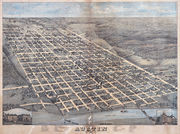
When Europeans first arrived, the area was inhabited by the Tonkawa tribe, and the Comanches and Lipan Apaches were known to travel through the area as well.[18] Spanish explorers, including the Espinosa-Olivares-Aguirre expedition, traveled through the area for centuries, though few permanent settlements were created for some time.[19] In the mid 18th century, the San Xavier missions were established along the San Gabriel River, in what is now western Milam County, to facilitate exploration.[20]
In the early 1800s, Spanish forts were established in what are now Bastrop and San Marcos.[19][21] Following the independence of Mexico, new settlements were established in Central Texas, but growth in the region was stagnant because of conflicts with the regional Native Americans.[21][22][23]
In 1835–1836, Texans fought for independence in the Texas Revolution and won. Texas thus became its own independent country with its own president, congress and monetary system. In 1839, the Texas Congress formed a commission to seek a site for a new capital to be named for Stephen F. Austin.[24] Mirabeau B. Lamar, second president of the newly formed Republic of Texas, advised the commissioners to investigate the area named Waterloo, noting the area's hills, waterways, and pleasant surroundings.[25] Waterloo was selected and the name Austin was chosen as the town's new name.[26] The location was seen as a convenient crossroads for trade routes between Santa Fe and Galveston Bay, as well as routes between northern Mexico and the Red River.[27] Austin is also the site where the southern leg of the Chisholm Trail leads to the Colorado River.[28]
Edwin Waller was picked by Lamar to survey the village and draft a plan laying out the new capital.[24] The original site was narrowed to 640 acres (259 ha) that fronted the Colorado River between two creeks, Shoal Creek and Waller Creek, which was later named in his honor. The fourteen-block grid plan was bisected by a broad north-south thoroughfare, Congress Avenue, running up from the river to Capital Square, where the new Texas State Capitol was to be constructed. A temporary one-story capitol was erected on the corner of Colorado and 8th Streets. On August 1, 1839, the first auction of 217 out of 306 lots total was held.[24][27] The grid plan that Waller designed and surveyed now forms the basis of Downtown Austin.
In 1840, a series of conflicts between the Texas Rangers and the Comanches, known as the Council House Fight and the Battle of Plum Creek, finally pushed the Comanches westward, mostly ending conflicts in Central Texas.[29] Settlement in the area began to expand quickly. Travis County was established in 1840 and the surrounding counties were mostly established within the next two decades.[23]
Initially, the new capital thrived. But Lamar's political enemy Sam Houston used two Mexican army incursions to San Antonio as an excuse to move the government to Washington-on-the-Brazos.[30] Remaining Austin residents responded to the threat by forcibly keeping the national archives in their city in defiance of President Houston's attempts to bring them to Washington (Texas Archive War). Once the annexation of the Republic of Texas by the United States became official in 1845, delegates wrote a new state constitution in which Austin was again named the seat of state.
In 1861, with the outbreak of the American Civil War, voters in Austin and other Central Texas communities voted against secession.[21][24] However, as the war progressed and fears of attack by Union forces increased, Austin contributed hundreds of men to the Confederate forces. With the end of the war and the emancipation of Texas' slaves, the African American population of Austin swelled dramatically. Black communities such as Wheatville, Pleasant Hill, and Clarksville were established around Austin by these newcomers.[24] The postwar period saw dramatic population and economic growth. The opening of the Houston and Texas Central Railway (H&TC) in 1871,[31] into the major trading center for the region with the ability to transport both cotton and cattle. The Missouri, Kansas, and Texas (MKT) line followed close behind.[32] Austin was also the terminus of the southernmost leg of the Chisholm Trail and "drovers" pushed cattle north to the railroad.[33] Cotton was one of the few crops produced locally for export and a cotton gin engine was located downtown near the trains for "ginning" cotton of its seeds and turning the product into bales for shipment.[34] However as other new railroads were built through the region in 1870s, Austin began to lose its primacy in trade to the surrounding communities.[24] In addition, the areas east of Austin took over cattle and cotton production from Austin, especially in towns like Hutto and Taylor that sit over the blackland prairie with deep, rich soils for producing cotton and hay.[35][36]
In September 1881, Austin public schools held their first classes. The same year, Tillotson Collegiate and Normal Institute (now part of Huston-Tillotson University) opened its doors. The University of Texas held its first classes in 1883, although classes had been held in the original wooden state Capitol for four years before.[37]
During the 1880s, Austin gained new prominence as the state capitol building was completed in 1888, and claimed as the 7th largest building in the world.[24] In the late 1800s, Austin expanded its city limits to more than three times its former area and the first granite dam was built on the Colorado River to power a new street car line and the new "moon towers.".[24] Unfortunately the first dam washed away in a flood on April 6, 1909.[38] It was finally replaced in 1940 by a hollow concrete dam[39] that formed Lake McDonald (now called Lake Austin)and which has withstood all floods since. In addition, the much larger Mansfield Dam was built by the LCRA upstream of Austin to form the flood-control lake, Lake Travis.[40] In the early 1900s, the Texas Oil Boom took hold, creating tremendous economic opportunities in Southeast Texas and North Texas. The growth generated by this boom largely passed by Austin at first, with the city slipping from 4th largest to 10th largest in Texas between 1880 and 1920.[24]
Beginning in the 1920s and 1930s, Austin launched a series of civic development and beautification projects that created much of the city's infrastructure and parks. In addition, the state legislature established the Lower Colorado River Authority that, along with the City of Austin, created the system of dams along the Colorado River that formed the Highland Lakes. These projects were enabled in large part by the fact that Austin received more Depression era relief funds than any other Texas city.[24]
After the mid-1900s, Austin became established as one of Texas' major metropolitan centers. In the late 20th century, Austin emerged as an important high tech center for semiconductors and software. The University of Texas emerged as a major university.[41]
The 1970s also saw Austin's emergence in the national music scene, with artists such as Willie Nelson and venues such as the Armadillo World Headquarters. The long-running television program Austin City Limits and the annual South by Southwest musical festival helped to solidify the city's place in the music industry.[11]
Geography
| Austin | ||||||||||||||||||||||||||||||||||||||||||||||||||||||||||||
|---|---|---|---|---|---|---|---|---|---|---|---|---|---|---|---|---|---|---|---|---|---|---|---|---|---|---|---|---|---|---|---|---|---|---|---|---|---|---|---|---|---|---|---|---|---|---|---|---|---|---|---|---|---|---|---|---|---|---|---|---|
| Climate chart () | ||||||||||||||||||||||||||||||||||||||||||||||||||||||||||||
|
||||||||||||||||||||||||||||||||||||||||||||||||||||||||||||
|
||||||||||||||||||||||||||||||||||||||||||||||||||||||||||||
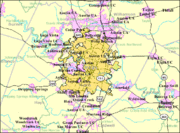
Austin is located in Central Texas along the Balcones Escarpment and Interstate 35, northeast of San Antonio. Its elevation varies from 425 feet (130 m) to approximately 1,000 feet (305 m) above sea level.[42] As of 2010 the city occupies a total area of 271.8 square miles (704 km2).[43] Approximately 6.9 square miles (18 km2) of this area is water.[44]
Austin is situated on the Colorado River, with three man-made (artificial) lakes within the city limits: Lady Bird Lake, Lake Austin (both created by dams along the Colorado River), and Lake Walter E. Long that is partly used for cooling water for the Decker Power Plant. Additionally, the foot of Lake Travis, including Mansfield Dam, is located within the city's limits.[24] Lady Bird Lake, Lake Austin, and Lake Travis are each on the Colorado River.[24] As a result of its straddling the Balcones Fault, the eastern part of the city is flat with heavy clay and loam soils, whereas, the western part and western suburbs consist of rolling hills on the edge of the Texas Hill Country.[45] Because the hills to the west are primarily limestone rock with a thin covering of topsoil, portions of the city are frequently subjected to flash floods from the runoff caused by thunderstorms.[46][47] To help control this runoff and to generate hydroelectric power, the Lower Colorado River Authority operates a series of dams that form the Texas Highland Lakes. The lakes also provide venues for boating, swimming, and other forms of recreation within several parks on the lake shores.[48]
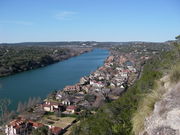
Austin is located at the intersection of four major ecological regions and is consequently a temperate-to-hot green oasis with a highly variable climate having some characteristics of the desert, the tropics, and a wetter climate.[49] The area is very diverse ecologically and biologically, and is home to a variety of animals and plants.[50] Notably the area is home to many types of wildflowers that blossom throughout the year but especially in the spring, including the popular bluebonnets, some planted in an effort by "Lady Bird" Johnson, wife of former President Johnson.[51]
A popular point of prominence in Austin is Mount Bonnell. At about 780 feet (238 m) above sea level, it is a natural limestone formation overlooking Lake Austin on the Colorado River, with an observation deck about 200 feet (61 m) below its summit. From the observation deck, many homes are visible.
The soils of Austin range from shallow, gravelly clay loams over limestone in the western outskirts to deep, fine sandy loams, silty clay loams, silty clays or clays in the city's eastern part. Some of the clays have pronounced shrink-swell properties and are difficult to work under most moisture conditions. Many of Austin's soils, especially the clay-rich types, are slightly to moderately alkaline and have free calcium carbonate.[52]
Climate
Austin has a humid subtropical climate (Köppen Cfa), characterized by hot summers and mild winters. On average, Austin receives 33.6 inches (853.4 mm) of rain per year, with most of the precipitation in the spring, and a secondary maximum in the fall.[53] During springtime, severe thunderstorms sometimes occur, though tornadoes are rare in the city. Austin is usually at least partially sunny, receiving nearly 2650 hours, or 60.3% of the possible total, of bright sunshine per year.[54]
Austin summers are usually hot and humid, with average July and August highs in the mid-90s °F (34–36 °C). Highs exceed 90 °F (32.2 °C) on 109 days per year, and 100 °F (37.8 °C) on 12.[53] The highest recorded temperature was 112 °F (44 °C) on September 5, 2000.[55][56]
Winters in Austin are mild and relatively dry. For the entire year, Austin averages 88 days below 45 °F (7.2 °C) and 24 days when the minimum temperature falls below freezing. The lowest recorded temperature was −2 °F (−19 °C) on January 31, 1949.[57] Snowfall is rare in Austin, but approximately biannually Austin may suffer an ice storm that freezes roads over and affects much of the city for 24 to 48 hours.[57] Monthly averages for Austin's weather data are shown in a graphical format to the right, and in a more detailed tabular format below.
| Climate data for Camp Mabry, Austin, Texas | |||||||||||||
|---|---|---|---|---|---|---|---|---|---|---|---|---|---|
| Month | Jan | Feb | Mar | Apr | May | Jun | Jul | Aug | Sep | Oct | Nov | Dec | Year |
| Record high °F (°C) | 90 (32.2) |
99 (37.2) |
98 (36.7) |
99 (37.2) |
104 (40) |
108 (42.2) |
108 (42.2) |
110 (43.3) |
112 (44.4) |
100 (37.8) |
91 (32.8) |
90 (32.2) |
112 (44.4) |
| Average high °F (°C) | 60.3 (15.72) |
65.1 (18.39) |
72.5 (22.5) |
78.9 (26.06) |
84.8 (29.33) |
90.9 (32.72) |
95.0 (35) |
95.6 (35.33) |
90.1 (32.28) |
81.4 (27.44) |
70.1 (21.17) |
62.3 (16.83) |
78.9 (26.06) |
| Average low °F (°C) | 40.0 (4.44) |
44.0 (6.67) |
50.9 (10.5) |
57.6 (14.22) |
65.4 (18.56) |
71.1 (21.72) |
73.4 (23) |
73.3 (22.94) |
68.8 (20.44) |
59.8 (15.44) |
49.3 (9.61) |
41.9 (5.5) |
58.0 (14.44) |
| Record low °F (°C) | −2 (-18.9) |
−1 (-18.3) |
18 (-7.8) |
30 (-1.1) |
40 (4.4) |
51 (10.6) |
57 (13.9) |
58 (14.4) |
41 (5) |
30 (-1.1) |
20 (-6.7) |
4 (-15.6) |
−2 (-18.9) |
| Precipitation inches (mm) | 1.89 (48) |
1.99 (50.5) |
2.14 (54.4) |
2.51 (63.8) |
5.03 (127.8) |
3.81 (96.8) |
1.97 (50) |
2.31 (58.7) |
2.91 (73.9) |
3.97 (100.8) |
2.68 (68.1) |
2.44 (62) |
33.65 (854.7) |
| Avg. precipitation days (≥ 0.01 in) | 7.7 | 7.0 | 7.9 | 7.2 | 9.5 | 7.5 | 5.1 | 5.2 | 7.2 | 7.4 | 8.2 | 7.9 | 87.8 |
| Sunshine hours | 164.3 | 169.5 | 204.6 | 207.0 | 226.3 | 285.0 | 316.2 | 297.6 | 234.0 | 217.0 | 168.0 | 155.0 | 2,644.5 |
| Source: NOAA,[53] The Weather Channel,[56] HKO [54] | |||||||||||||
Government and politics
Law and government
Austin is administered by a city council of seven members, each of them elected at large. The council is composed of six council members, and by an elected mayor, accompanied by a hired city manager under the manager-council system of municipal governance. Council and mayoral elections are non-partisan, with a runoff in case there is no majority winner. Austin remains an anomaly among large Texas cities in that council members are elected on an at-large basis by all voters, as opposed to elections by districts.
Austin formerly operated its city hall at 128 West 8th Street.[58] Antoine Predock and Cotera Kolar Negrete & Reed Architects designed a new city hall building, which was intended to reflect what The Dallas Morning News referred to as a "crazy-quilt vitality, that embraces everything from country music to environmental protests and high-tech swagger."[59] The new city hall, built from recycled materials, has solar panels in its garage.[60] The city hall, at 301 West Second Street, opened in November 2004.[61] The current[update] mayor of Austin is Lee Leffingwell. His first term ends in 2012.
Law enforcement in Austin is provided by the Austin Police Department, except for state government buildings, which are patrolled by the Texas Department of Public Safety. Austin was ranked the fifth-safest city in part because there are fewer than five murders per 100,000 people annually.[62][63]
Fire protection is provided by the Austin Fire Department, and emergency medical services are provided by Austin-Travis County Emergency Medical Services.
State and federal representation
The Texas Department of Transportation operates the Austin District Office in Austin.[64]
The Texas Department of Criminal Justice (TDCJ) operates the Austin I and Austin II district parole offices in Austin.[65]
The United States Postal Service operates several post offices in Austin.
Politics
The controversy that dominated Austin politics during the 1990s was the conflict between environmentalists and advocates of urban growth. The city council has in the past tried to mitigate the controversy by advocating smart growth, but growth and environmental protection are still the most divisive issues in city politics.
Austin is known as a center for liberal politics in a generally conservative state, so much so that the city is sometimes sarcastically referred to as "The People's Republic of Austin" by residents of other parts of the state and by conservatives in the Texas Legislature.[66][67]
As a result of the major party realignment that began in the 1970s, central Austin became a stronghold of the Democratic Party, while the suburbs tend to vote Republican. One consequence of this is that in the most recent redistricting plan, formulated by former U.S. Rep. Tom DeLay and enacted by the Republican-majority legislature, the central city has been split among multiple sprawling districts. Opponents characterized the resulting district layout as excessively partisan gerrymandering, and the plan was challenged in court on this basis by Democratic and minority activists; of note, the Supreme Court of the United States has never struck down a redistricting plan for being excessively partisan. The plan was subsequently upheld by a three-judge federal panel in late 2003, and on June 28, 2006, the matter was largely settled when the Supreme Court in a 7–2 decision upheld the entire congressional redistricting plan with the exception of a Hispanic-majority district in southwest Texas. This later affected Austin's districting, as U.S. Rep. Lloyd Doggett's district (U.S. Congressional District 25)was found not to be sufficiently compact to compensate for the reduced minority influence in the southwest district, and so was redrawn so that it now takes in most of southeastern Travis County and several counties to its south and east.[68]
Overall, the city is a blend of downtown liberalism and suburban conservatism but leans slightly to the political left as a whole. In 2003, the city adopted a resolution against the USA PATRIOT Act that reaffirmed constitutionally guaranteed rights. In the 2004 presidential election, Senator John Kerry won a substantial majority of the votes in Travis County.[69] Of Austin's six state legislative districts, three are strongly Democratic and three are swing districts all of which are held by Democrats. However, two of its three congressional districts (the 10th and the 21st) are presently held by Republicans, with only the 25th held by a Democrat. This is largely due to the 2003 redistricting, which left downtown Austin without an exclusive congressional seat of its own. Travis County was also the only county in Texas to reject Texas Constitutional Amendment Proposition 2–effectively outlawing gay marriage and status equal or similar to it–and did so by a wide margin (40% for, 60% against).[70][71][72]
Austin is also an active area for the Libertarian Party. Although the Libertarians remain a third party, they occasionally garner substantial votes, and one of the past Libertarian presidential candidates, Michael Badnarik, comes from Austin.
Two of the candidates for president in the 2004 race call Austin home. Michael Badnarik, mentioned above as the Libertarian Party candidate, and David Cobb of the Green Party both have lived in Austin. During the run up to the election in November, a presidential debate was held at the University of Texas student union involving the two minor party candidates. While the Commission on Presidential Debates only invites Democrats and Republicans to participate in televised debates, the debate at UT was open to all presidential candidates. Austin also hosted one of the last presidential debates between Barack Obama and Hillary Clinton during their heated race for the Democratic nomination in 2008.[73]
Environmental movement
The distinguishing political movement of Austin politics has been that of the environmental movement, which spawned the parallel neighborhood movement, then the more recent conservationist movement (as typified by the Hill Country Conservancy),[74] and eventually the current on-going debate about "sense of place" and preserving the Austin quality of life. Much of the so-called environmental movement has matured into a debate on issues related to saving and creating an Austin "sense of place." [75]
Economy

Austin is considered to be a major center for high tech.[76] Thousands of graduates each year from the engineering and computer science programs at The University of Texas at Austin provide a steady source of employees that help to fuel Austin's technology and defense industry sectors. The metro Austin area has much lower housing costs than Silicon Valley, but much higher housing costs than many parts of rural Texas. As a result of the high concentration of high-tech companies in the region, Austin was strongly affected by the dot-com boom in the late 1990s and subsequent bust.[76] Austin's largest employers include the Austin Independent School District, the City of Austin, Dell, the U.S. Federal Government, Freescale Semiconductor (spun off from Motorola in 2004), IBM, St. David's Healthcare Partnership, Seton Family of Hospitals, the State of Texas, Texas State University–San Marcos, and The University of Texas.[76] Other high-tech companies with operations in Austin include 3M, Apple Inc., Hewlett-Packard, Google, AMD, Applied Materials, Cirrus Logic, Cisco Systems, eBay/PayPal, Hoover's, Intel Corporation, National Instruments, Samsung Group, Silicon Laboratories, Sun Microsystems and United Devices. In 2010, Facebook accepted a grant to build a downtown office that could bring as many as 200 jobs to the city.[13] The proliferation of technology companies has led to the region's nickname, "the Silicon Hills", and spurred development that greatly expanded the city. The concentration of high-tech companies has led the former American Airlines flight between Austin and San Jose, California to be dubbed the "nerd bird." [77]
Austin is also emerging as a hub for pharmaceutical and biotechnology companies. About 85 companies from this industry are based in Austin.[76] The city was ranked by the Milken Institute as the #12 biotech and life science center in the United States.[78]
It is also home to national advertising agencies including Omnicom-owned GSD&M Idea City and LatinWorks as well as many other regionally respected agencies. Whole Foods Market is a grocery store that specializes in organic, local, and natural foods and other goods. It was founded and is based in Austin.
In addition to global companies, Austin features a strong network of independent, locally owned firms and organizations. The success of these businesses reflects the high level of commitment by the citizens of Austin to preserving the unique spirit of the city.
Cityscape


Buildings that make up most of Austin's skyline are modest in height and somewhat spread out. The latter characteristic is partly due to a restriction that preserves the view of the Texas State Capitol building from various locations around Austin (known as the Capitol View Corridor).[79] However, many new highrise towers have been constructed and the downtown area is looking more modern and dense. The city's tallest building, The Austonian, was topped out on September 17, 2009.[80] Austin is currently undergoing a skyscraper boom, which includes recent construction on the now complete 360 Condominiums at 563 feet (172 m), Spring (condominiums),the Austonian at 683 feet (208 m), and several others that are mainly for residential use. By 2015, the Frost Bank Tower could be the only skyscraper built before 2005 to remain in the ten tallest buildings in the city.
At night, parts of Austin are lighted by "artificial moonlight" from Moonlight Towers[81] built to illuminate the central part of the city. The 165-foot (50 m) moonlight towers were built in the late 19th century and are now recognized as historic landmarks. Only 17 of the 31 original innovative towers remain standing. The towers are featured in the 1993 film Dazed and Confused.
Downtown
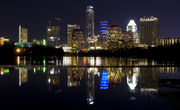
The central business district of the city is home to some of the tallest condo towers in the state, with the Austonian Condos topping out at 56 floors[82] and the 360 Condos at 44 floors.[83] The 360 Tower and the Four Seasons Condos are condo towers in Austin, opened in early 2008.[84] Former Mayor Will Wynn set out a goal for having up to 25,000 people living Downtown by 2015, and the city provided incentives for building residential units in the urban core.[85] Because of this, the city has been driven to increase density in Austin's urban core. The skyline has drastically changed in recent years, and the residential real estate market has remained relatively strong. Downtown growth has been aided by the presence of a popular live music and nightlife scene, museums, restaurants, and Lady Bird Lake, considered one of the city's best recreational spots. The 2nd Street District consists of several new residential projects, restaurants, coffee shops, record stores, upscale boutiques and museums, and the Austin City Hall. Under construction across 2nd Street from Austin City Hall will be the newly re-created TV set for the long-running PBS program Austin City Limits,[86] which will be housed beneath the new 478 feet (146 m) W Hotel[87] and residential tower. South by Southwest (SXSW)[88] is hosted downtown and is one of the largest music festivals in the United States, with more than 2,000 performers playing in more than 90 venues around Downtown Austin over four days, in March. Though it is an industry-based event, SXSW Music links locally with events such as the annual Austin Music Awards show. SXSW is the highest revenue-producing special event for the Austin economy, with an estimated economic impact of at least $110 million in 2008. [89]
Demographics
| Historical populations | |||
|---|---|---|---|
| Census | Pop. | %± | |
| 1850 | 629 |
|
|
| 1860 | 3,494 | 455.5% | |
| 1870 | 4,428 | 26.7% | |
| 1880 | 11,013 | 148.7% | |
| 1890 | 14,575 | 32.3% | |
| 1900 | 22,258 | 52.7% | |
| 1910 | 29,860 | 34.2% | |
| 1920 | 34,876 | 16.8% | |
| 1930 | 53,120 | 52.3% | |
| 1940 | 87,930 | 65.5% | |
| 1950 | 132,459 | 50.6% | |
| 1960 | 186,545 | 40.8% | |
| 1970 | 251,808 | 35.0% | |
| 1980 | 345,496 | 37.2% | |
| 1990 | 472,020 | 36.6% | |
| 2000 | 656,562 | 39.1% | |
| Est. 2009 | 786,382 | 19.8% | |
According to the 2006-2008 American Community Survey, the racial composition of Austin is:
Single Race: 97.7%
- White: 63.7%
- Black or African American: 8.2%
- American Indian: 0.4%
- Asian: 5.5%
- Native Hawaiian and Other Pacific Islander: 0.1%
- Some other race: 19.8%
Two or More Races: 2.3%
According to the same survey, the ethnic composition of Austin is:
- Hispanic or Latino: 35%
- Not Hispanic or Latino: 65%[90]
As of the census[5] of 2000, there were 656,562 people, 265,649 households, and 141,590 families residing in the city (roughly comparable in size to San Francisco, USA; Leeds, UK; and Ottawa, Canada). The population density was 2,610.4 people per square mile (1,007.9/km²). There were 276,842 housing units at an average density of 1,100.7/sq mi (425.0/km²). There were 265,648 households out of which 26.8% had children under the age of 18 living with them, 38.1% were married couples living together, 10.8% had a female householder with no husband present, and 46.7% were non-families. 32.8% of all households were made up of individuals and 4.6% had someone living alone who was 65 years of age or older. The average household size was 2.40 and the average family size was 3.14.
In the city the population was spread out with 22.5% under the age of 18, 16.6% from 18 to 24, 37.1% from 25 to 44, 17.1% from 45 to 64, and 6.7% who were 65 years of age or older. The median age was 30 years. For every 100 females there were 105.8 males.
The median income for a household in the city was $42,689, and the median income for a family was $54,091. Males had a median income of $35,545 vs. $30,046 for females. The per capita income for the city was $24,163. About 9.1% of families and 14.4% of the population were below the poverty line, including 16.5% of those under age 18 and 8.7% of those age 65 or over. The median house price was $185,906 in 2009, and it has increased every year since 2003.[91]
According to the US Census Bureau as of July 2009, the Austin–Round Rock metropolitan area had 1,705,075 people (roughly comparable to the San Jose, California area in the U.S.; the West Yorkshire area in the U.K.; and the Marseille area in France). It is one of the five fastest-growing metro areas in the nation.
Austin is consistently ranked among the three safest cities per capita of any size in many categories. Its annual murder rate is fewer than five people per 100,000 residents.
Arts and culture
Austinites take pride in personal eccentricities. Austin is the only major Texas city that has no ordinance against women appearing topless in public. "Keep Austin Weird" has become a local motto in recent years, featured on bumper stickers and t-shirts. This motto has not only been used in promoting Austin's eccentricity and diversity, but is also meant to bolster support of local independent businesses.[16] According to the Nielsen Company, adults in Austin read and contribute to blogs more than those in any other U.S. metropolitan area.[92] Austin residents have the highest internet usage in all of Texas.[92]
Austin was selected as the No. 2 Best Big City in "Best Places to Live" by Money magazine in 2006, and No. 3 in 2009, and also the "Greenest City in America" by MSN.[93][94] According to Travel & Leisure magazine, Austin ranks No. 1 on the list of cities with the best people, referring to the personalities and attributes of the citizens.[95]
SoCo is a shopping district stretching down South Congress Avenue from Downtown. This area is home to coffee shops, eccentric stores, restaurants and festivals. It prides itself on "Keeping Austin Weird", despite development surrounding the area.
Annual cultural events

The O. Henry House Museum hosts the annual O. Henry Pun Off, a pun contest where the contestants exhibit wit. Other annual events include Eeyore's Birthday Party, Spamarama, the Austin Reggae Festival and Art City Austin in April, East Austin Studio Tour in November, and Carnaval Brasileiro in February. Sixth Street features annual festivals such as the Pecan Street Festival and Halloween night. The three-day Austin City Limits Music Festival has been held in Zilker Park every year since 2002.
Austin's Zilker Park Tree is a Christmas display made of lights strung from the top of a Moonlight tower in Zilker Park. The Zilker Tree is lit in December along with the "Trail of Lights", an Austin Christmas tradition.
Music
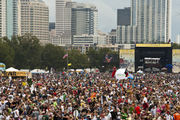
As Austin's official slogan is The Live Music Capital of the World, the city has a vibrant live music scene with more music venues per capita than any other U.S. city.[1][2] Austin's music revolves around the many nightclubs on 6th Street and an annual film/music/interactive festival known as South by Southwest (SXSW). The longest-running concert music program on American television, Austin City Limits, is recorded on the University of Texas at Austin campus. Austin City Limits and C3 Presents produce the Austin City Limits Music Festival, an annual music and art festival held at Zilker Park in Austin based on the Austin City Limits television show. The festival and television show alike attract musical artists from around the world. Other music events include the Urban Music Festival, the Fun Fun Fun Fest, Chaos In Tejas and the Old Settlers Music Festival. The Austin Symphony Orchestra traces its roots to 1911.
Film
Austin hosts the annual Austin Film Festival, which draws films of many different types from all over the world. In 2004 the city was first in Moviemaker Magazine's annual top ten cities to live and make movies. The 2007 South by Southwest (SXSW) festival included Pete Townshend, Iggy Pop, Tom Morello, and Rickie Lee Jones.
Austin has been the location for a number of motion pictures, partly due to the influence of The University of Texas at Austin Department of Radio-Television-Film. Films produced in Austin include Man of the House, Secondhand Lions, Waking Life, Spy Kids, Dazed and Confused, Office Space, The Life of David Gale, Miss Congeniality, Doubting Thomas, Slacker, Idiocracy, The New Guy, Hope Floats, The Alamo, Blank Check, The Wendall Baker Story, A Scanner Darkly, and most recently, Grindhouse, Machete, How To Eat Fried Worms and Bandslam. In order to draw future film projects to the area, the Austin Film Society has converted several airplane hangars from the former Mueller Airport into filmmaking center Austin Studios. Projects that have used facilities at Austin Studios include music videos by The Flaming Lips and feature films such as 25th Hour and Sin City. Austin also hosted the MTV series, The Real World: Austin in 2005. The film review websites Spill.com and Ain't It Cool News are based in Austin.
Media
Austin's main daily newspaper is the Austin American-Statesman. The Austin Chronicle is Austin's alternative weekly, while The Daily Texan is the student newspaper of the University of Texas. Austin's business newspapaer is the weekly Austin Business Journal. Austin also has numerous smaller special interest or sub-regional newspapers such as the Oak Hill Gazette, Westlake Picayune, Hill Country News, Round Rock Leader, NOKOA, and The Villager among others. Texas Monthly, a major regional magazine, is also headquartered in Austin. The Texas Observer, a muckraking biweekly political magazine, has been based in Austin for over five decades. The most recent newspaper entrant is the weekly Community Impact Newspaper newspaper published by John Garrett, former publisher of the Austin Business Journal. Community Impact has five regional editions and is delivered to every house and business within certain zip codes and all of the news is specific to those zip codes.[96] The local PBS station KLRU produces several award winning locally produced programs.[97] KUT is the leading public radio station in Texas and produces the majority of its content locally.[98] KOOP (FM) is a volunteer-run radio station with more than 60 locally produced programs.[99] Network television stations (affiliations in parentheses) include KTBC (Fox), KVUE (ABC), KXAN (NBC), KEYE-TV (CBS), KLRU (PBS), KNVA (The CW), KBVO (My Network TV), and KAKW (Univision). Also, subscribers to Time Warner Cable receive a 24-hour local news station, News 8 Austin. In some parts of Austin, Time Warner has cable competition from Grande Communications.
The most recent entrant on the Austin news scene is The Texas Tribune, an on-line publication focused on Texas and Austin politics.[100] The Tribune is "user-supported" through donations, a business model similar to public radio.[101] The Editor is Evan Smith, former Editor of Texas Monthly. Smith co-founded the Texas Tribune, a nonprofit, non-partisan public media organization, with Austin venture capitalist John Thornton and veteran journalist Ross Ramsey.[100][102]
Theater
Austin has a strong theater culture, with dozens of itinerant and resident companies producing a variety of work. The city also has live performance theater venues such as the Zachary Scott Theatre Center, Vortex Repertory Company, Salvage Vanguard Theater, Rude Mechanicals, Scottish Rite Children's Theater, Hyde Park Theatre, and Esther's Follies, a comedy and magic show.[103] The Victory Grill was a renowned venue on the Chitlin' circuit.[104] Public art and performances in the parks and on bridges are popular. Austin hosts the Fuse Box Festival each April featuring international, leading-edge theater artists.[105]
The Paramount Theatre, opened in downtown Austin in 1915, contributes to Austin's theater and film culture, showing classic films throughout the summer and hosting regional premieres for films such as Miss Congeniality.[106] The Zilker Park Summer Musical is a long-running outdoor musical.[107]
The Long Center for the Performing Arts is a 2,300 seat theater built partly with recycled materials from the old Lester E. Palmer Auditorium.
Ballet Austin is the fourth largest ballet academy in the country.[108] Each year Ballet Austin's twenty member professional company performs ballets from a wide variety of choreographers, including their international award winning artistic director, Stephen Mills. The city is also home to the Ballet East Dance Company, a modern dance ensemble, and the Tapestry Dance Company which performs a variety of dance genres.
Austin Lyric Opera has, since its founding in 1986, provided area residents with performances of multiple operas each year (including the 2007 opening of Philip Glass's Waiting for the Barbarians, written by University of Texas alumnus J. M. Coetzee). Performances are held at the Long Center for the Performing Arts with outdoor performance at Zilker Hillside Theater.[109]
Austin Symphony Orchestra, founded in 1911, is the oldest continuously performing symphony in the State of Texas and oldest performing arts group in Austin. Austin Symphony performs a range of classical, pop and family performances and is lead by Music Director and Conductor Peter Bay.
The growing Austin improv comedy scene is spread over several theaters: ColdTowne Theater, The Hideout Theater, The New Movement Theater, and Salvage Vanguard Theater. Some of Austin's best known improv troupes include ColdTowne, The Frank Mills, Girls Girls Girls, Parallelogramophonograph, and Get Up. Austin also hosts the annual Out of Bounds Comedy Festival which draws comedic artists in all disciplines to Austin. In 2009, Out of Bounds hosted over 300 improv and sketch comedy artists over 7 days in 7 different venues.
Entrepreneurship
Austin has an emerging Entrepreneurship Scene, which supports multiple entrepreneurial paths, including craft, bootstrap and funding-driven. The scene comes together every March at RISE Austin, an annual week-long conference around the city. The Scene have been featured in BusinessWeek, Entrepreneur Magazine (twice, and a THIRD time), GigaOm, Time, ABJ Entrepreneur, Kiplinger and CNN.
Sports
Austin is the largest city in the United States without a franchise in a major professional sports league.[110] Many Austinites support the University of Texas Longhorns' sports programs. The University of Texas football and baseball teams each won their respective national championships during the 2005–2006 seasons.[111][112] The Texas Longhorns play home games in the state's second-largest sports stadium, Darrell K Royal-Texas Memorial Stadium, seating over 101,000 fans.[113] Baseball games are played at UFCU Disch–Falk Field which underwent renovation in 1996 with an increased capacity to 6,756 seats plus 11 stadium suites.
Minor-league professional sports came to Austin in 1996, when the Austin Ice Bats began playing at the Travis County Expo Center.[114] Since then, the Austin Ice Bats have been replaced by the Texas Stars[115] of the American Hockey League, and many other teams have come to Austin including the Austin Toros of the NBA Development League, the Texas Stars, and the Austin Aztex FC, a professional soccer team of the USL First Division.

-
Austin area minor-league professional sports teams Club Sport Founded League Venue Round Rock
ExpressBaseball 1999 Pacific Coast League Dell Diamond Austin Aztex U23 Soccer 2008 USL Premier
Development LeagueDragon Stadium Austin Aztex FC Soccer 2009 United Soccer
Leagues -
First DivisionNelson Field (2009) and
House Park(2010+)Austin Outlaws Football 2003 National Women's
Football AssociationHouse Park Austin Toros Basketball 2005 NBA D-League Cedar Park Center Texas Stars Ice hockey 2009 American Hockey
LeagueCedar Park Center Austin Turfcats Indoor football 2009 Southern Indoor
Football LeagueLuedecke Arena Austin
GamebreakersFootball 1998 North American
Football LeagueYellow Jacket Stadium
I Natural features like the bicycle-friendly Texas Hill Country, limestone rock formations, and generally mild climate work with the centrally located Lady Bird Lake Hike and Bike Trail, and local pools like Barton Springs to make Austin the home of several endurance and multi-sport races and communities. The Capitol 10,000 is the largest 10 K race in Texas, and approximately fifth largest in the nation. The Austin Marathon has been run in the city every year since 1992. The Austin-founded American Swimming Association hosts an open water swimming event, the Cap 2 K, and other closed-course, open water, and cable swim races around town. Austin is also the hometown of several cycling groups and the seven-time Tour de France champion cyclist [116] Lance Armstrong, as well as environmentally and economically minded bicycle commuters. Combining these three disciplines is a growing crop of triathlons, including the Capital of Texas Triathlon held every Memorial Day on and around Lady Bird Lake, Auditorium Shores, and Downtown Austin.[117]
In June 2010 it was announced by the Formula One chief executive Bernie Ecclestone that the Austin area would host the Formula One, United States Grand Prix, from 2012 until 2021. The effort was aided by State Comptroller Susan Combs. The state has pledged to put up $25 million in public funds annually for 10 years to pay the sanctioning fees for the race.[118] The event was last held in 2007 at the Indianapolis Motor Speedway.[119]. A Formula One circuit will need to be built at an estimated cost of $250 to $300 million, paid for by private investors, and is expected to be located just east of the Austin Bergstrom International Airport. The Austin investor group is headed by Tavo Hellmund,[120] President of Full Throttle Productions, LP. Hellmund, of Austin, is himself a former race car owner and driver.[121]
Museums and other points of interest
Museums in Austin include the Texas Memorial Museum, the Blanton Museum of Art (reopened in 2006), the Bob Bullock Texas State History Museum across the street (which opened in 2000), the Austin Museum of Art (AMOA), and the galleries at the Harry Ransom Center. The Texas State Capitol itself is also a major tourist attraction. The Driskill Hotel built in 1886, and located at 6th and Brazos, was finished just before the construction of the Capitol building. Sixth Street is a musical hub for the city. The Enchanted Forest, a multi-acre outdoor music, art, and performance art space in South Austin hosts events such as fire-dancing and circus-like-acts.[122] Austin is also home to the Lyndon Baines Johnson Library and Museum, which houses documents and artifacts related to the Johnson administration, including LBJ's limousine and a recreation of the Oval Office.
The art that gave Austin its reputation for being weird is featured at the South Austin Museum of Popular Culture. The Mexic-Arte Museum is a Latin American art museum founded in 1983. Austin is also home to the O. Henry House Museum, which is where O. Henry lived in Austin in 1891. Farmers markets are popular attractions, providing a variety of locally grown and often organic goods.[123]
Austin is also "weird" for its many statues and landmarks, such as the Hyde Park Bar & Grill fork, the Mangia dinosaur, the Loca Maria lady at Taco Xpress on South Lamar, the pink flamingo lawn in front of the Pots and Plants Garden Center, the Hyde Park Gym's giant flexed arm, and Daniel Johnston's Hi, how are you? frog mural. Austin locals are proud of these landmarks and work to preserve them, even as the city grows.[124]
The Ann W. Richards Congress Avenue Bridge houses the world's largest urban population of Mexican Free-tailed Bats. Starting in March,[125][126] up to 1.5 million bats take up residence inside the bridge's expansion and contraction zones as well as in long horizontal grooves running the length of the bridge's underside, an environment ideally suited for raising their young. Every evening around sunset, the bats emerge in search of insects, an exit visible on weather radar. Watching the bat emergence is an event that is popular with locals and tourists, with more than 100,000 viewers per year. The bats migrate to Mexico each winter.[127]
The Austin Zoo, located in unincorporated western Travis County is a rescue zoo that provides sanctuary to displaced animals from a variety of situations, including those involving neglect.
Parks and recreation
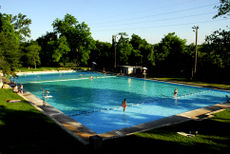
The Austin Parks & Recreation Department received the Excellence in Aquatics award in 1999 and the Gold Medal Awards in 2004 from the National Recreation and Park Association.[128][129] Home to more than 50 public swimming pools, Austin has parks and pools throughout the city. There are several well-known swimming locations. These include Deep Eddy Pool, Texas' oldest man-made swimming pool, and Barton Springs Pool, the nation's largest natural swimming pool in an urban area.[130][131] Barton Springs Pool is spring-fed while Deep Eddy is well-fed. Both range in temperature from about 68.0 °F (20.0 °C) during the winter to about 71.6 °F (22.0 °C) during the summer.[132][133][134] Hippie Hollow Park, a county park situated along Lake Travis, is the only officially sanctioned clothing-optional public park in Texas. Activities include rockclimbing, kayaking, swimming, exploring, and hiking along the greenbelt, a long-spanning area that runs through the city. Zilker Park, a large green area close to downtown, forms part of the greenbelt along the Colorado River. Hamilton Pool is a pool and wildlife park located about 30 minutes from the city.[135]
Transportation
Highways
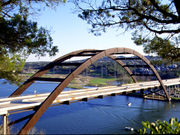
Central Austin is essentially bracketed by two major North/South thoroghfares: Interstate 35 to the east and the Mopac Expressway (Loop 1) to the west. U.S. Highway 183 runs from northwest to southeast, and State Highway 71 crosses the southern part of the city from east to west, completing a rough "box" around the central and north-central city. Austin is the largest city in the United States to be served by only one Interstate Highway.
U.S. Highway 290 enters Austin from the east and merges into I-35. Its highway designation continues south on I-35 and then becomes part of Highway 71, continuing on to the west. Highway 290 becomes its own road again southwest of the city, when it splits from Highway 71 in a busy interchange in Oak Hill known as "The Y." Highway 71 continues as far west as Brady, Texas, and Highway 290 continues west to intersect Interstate 10 near Junction. Interstate 35 continues south through San Antonio, and continues to its culmination at Laredo, Texas, which is on the Texas-Mexico border. Interstate 35 is the highway link to the Dallas-Ft. Worth metroplex in northern Texas. There are two links to Houston, Texas (Highway 290 and State Highway 71/Interstate 10). Highway 183 leads northwest of Austin and is a route with other major highways to such cities as Abilene, San Angelo, Lubbock, Amarillo, Albuquerque and Denver.
In the mid-1980s, Austin completed construction on Loop 360, a scenic highway that curves through the hill country from near the 71/Mopac interchange in the south to near the 183/Mopac interchange in the north. The iconic Pennybacker Bridge, also known as the "360 Bridge", crosses Lake Austin to connect north and south Loop 360.
Tollways
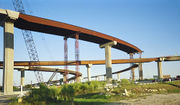
In November 2006, Austin opened the first segments of its first-ever tollway system: State Highway 130 runs from just south of Austin-Bergstrom International Airport to Interstate 35 just north of Georgetown. Highway 130 connects with Highway 45 in Pflugerville, Texas. The project, when completed, will end at Interstate 10 just east of Seguin, about 30 miles east-northeast of San Antonio.
State Highway 45 runs east-west from just west of Highway 183 in Cedar Park to 130 inside Pflugerville (just east of Round Rock). The project also included a tolled extension to Mopac that allows direct access to I-35. A new southeast leg of Highway 45 has recently been completed, connecting US 183 and the current south end of TX-130 to I-35 at the FM 1327/Creedmoor exit near the south end of Austin and close to the town of Buda's northernmost interchange. The 183A Toll Road opened March 2007, providing a tolled alternative to 183 through the cities of Leander and Cedar Park. Despite the overwhelming initial opposition to the toll road concept when it was first announced, all three toll roads have improved mobility in and around the Austin area and are significantly exceeding their revenue projections.[136]
Airports
Austin's airport is Austin-Bergstrom International Airport (ABIA) (IATA code AUS), located 5 miles (8 km) southeast of the city. The airport is on the site of the former Bergstrom Air Force Base, which was closed in 1993 as part of the Base Realignment and Closure process. Previously, Robert Mueller Municipal Airport was the commercial airport of Austin.
Intercity bus service
Greyhound Lines operates the Austin Station at 916 East Koenig Lane, just east of Airport Boulevard and adjacent to Highland Mall.[137] Turimex Internacional operates bus service from Austin to Nuevo Laredo and on to many destinations in Mexico. The Turimex station is located at 5012 East 7th Street, near Shady Lane.[138]
Public transportation
Capital Metropolitan Transportation Authority (Capital Metro) provides public transportation to the city, primarily by bus. Capital Metro is planning to change some routes to "Rapid Lines". The lines will feature 60 ft (18 m) long, train-like high-tech buses. This addition is going to be implemented to help reduce congestion. Capital Metro opened a 32-mile commuter rail system known as Capital MetroRail on March 22, 2010.[139] The system was built on existing freight rail lines and will serve downtown Austin, East Austin, North Central Austin, Northwest Austin, and Leander in its first phase. Future expansion could include a line to Manor and another to Round Rock. Capital Metro is also looking into a circulator system of streetcars to connect most of Downtown, the University of Texas, and the 700-acre (2.8 km2) Mueller Airport Redevelopment. The streetcar system would help connect the new rail line to key destinations in Central Austin. An Amtrak Texas Eagle station is located west of downtown. Segments of the Amtrak route between Austin and San Antonio are under evaluation for a future passenger rail corridor as an alternative to the traffic congestion of Interstate 35. Austin is known as the most bike-friendly city in Texas and has a Silver-level rating from the League of American Bicyclists. Austin is also home to Car2Go, a carsharing program. Austin was chosen as the first city in the western hemisphere to host this company's business, which is based in Germany.
Education
Researchers at Central Connecticut State University ranked Austin the 16th most literate city in the United States for 2008.[140] The Austin Public Library operates the John Henry Faulk Library and various library branches. The Travel Channel gave Austin the title "America's #1 College Town".[141]
Higher education
The University of Texas and seven other public and private universities and colleges have a combined enrollment of over 118,000. Within 200 miles of Austin, an additional 67 four-year colleges and universities enroll over 360,000 students. Nearly 40% of Austin area residents age 25 and over hold a bachelor's degree.[142] Austin is also home to the University of Texas at Austin, the flagship institution of the University of Texas System. The university has several internal colleges located inside the city including the College of Pharmacy, McCombs School of Business, the School of Architecture, and the School of Engineering. The University was ranked in 2010 in the Top 10 CEO Undergraduate Alma Maters by Bloomberg Businessweek.[143]
Other institutions of higher learning in Austin include Austin Community College, Concordia University, Huston-Tillotson University, St. Edward's University, the Seminary of the Southwest, the Acton School of Business, Austin Graduate School of Theology, Austin Presbyterian Theological Seminary, Virginia College's Austin Campus, The Art Institute of Austin, Austin Conservatory and a branch of Park University. Austin was voted America's #1 College Town by the Travel Channel.[141]
Public primary and secondary education
Highly rated elementary and secondary schools contribute to both quality of life and the beginnings of exceptional labor pools to come. Austin area households enjoy diverse options in education, including 29 public school districts, 17 charter schools and 69 private schools.[144] Most of the city is served by the Austin Independent School District. Some parts of Austin are served by other districts, including Round Rock, Pflugerville, Leander, Manor, Del Valle, Lake Travis, Hays, and Eanes ISDs. Four of the metro's major public school systems, representing 54% of area enrollment, are included in Expansion Management magazine's latest annual education quality ratings of nearly 2,800 school districts nationwide. Two districts—Eanes and Round Rock—are rated "gold medal", the highest of the magazine's cost-performance categories.[144]
Private and alternative education
Private and alternative education institutions for children in preschool-12th grade include Regents School of Austin, Redeemer Lutheran School, Garza (public), the Waldorf schools, The Griffin School, The Khabele School, Concordia Academy, St. Ignatius Martyr Catholic School, San Juan Diego Catholic High School, Brentwood Christian School, St. Austin Catholic School, St. Stephen's Episcopal School, St. Mary's, St. Theresa's, St. Michael's Catholic Academy, St. Gabriel's Catholic School, St. Andrew's Episcopal School, Austin Jewish Academy, St. Francis Episcopal School, Saint Paul Lutheran School, Trinity Episcopal School, Huntington-Surrey, Sri Atmanada, ACE Academy, many Montessori schools and finally Paragon Preparatory Middle School.
Sister cities
List of sister cities of Austin, Texas, designated by Sister Cities International.[145]
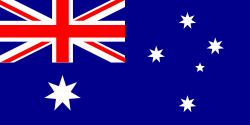 Adelaide, Australia – since 1983
Adelaide, Australia – since 1983 Koblenz, Germany – since 1991
Koblenz, Germany – since 1991 Lima, Peru – since 1981
Lima, Peru – since 1981 Maseru, Lesotho – since 1978
Maseru, Lesotho – since 1978 Ōita, Japan – since 1990
Ōita, Japan – since 1990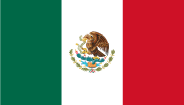 Saltillo, Mexico – since 1968
Saltillo, Mexico – since 1968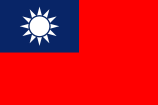 Taichung, Republic of China – since 1986
Taichung, Republic of China – since 1986 Orlu, Nigeria – since 2000
Orlu, Nigeria – since 2000 Gwangmyeong, South Korea
Gwangmyeong, South Korea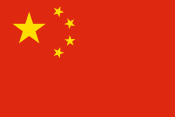 Xishuangbanna, People's Republic of China – since 1997
Xishuangbanna, People's Republic of China – since 1997 Antalya, Turkey
Antalya, Turkey Fethiye, Turkey- since 2008
Fethiye, Turkey- since 2008
The cities of Belo Horizonte, Brazil and Elche, Spain were formerly Sister Cities, but upon a vote of the Austin City Council in 1991, their status was de-activated.[146]
Notes
- ↑ 1.0 1.1 1.2 "Live Music Capital of the World". Austin City Connection. City of Austin. http://www.cityofaustin.org/music/. Retrieved June 12, 2007.
- ↑ 2.0 2.1 2.2 "The ATX". ATX Fest. http://www.atxfest.com/general_info.php. Retrieved April 6, 2007.
- ↑ "City of the Violet Crown". Austin City Connection. City Of Austin. http://www.ci.austin.tx.us/library/ahc/faq3.htm.
- ↑ 4.0 4.1 Christie, Les (July 1, 2009). "New Orleans: Fastest growing city". CNN/US Census Bureau. http://money.cnn.com/2009/07/01/news/economy/fastest_growing_cities/index.htm. Retrieved July 1, 2009.
- ↑ 5.0 5.1 "American FactFinder". United States Census Bureau. http://factfinder.census.gov. Retrieved 2008-01-31.
- ↑ "US Board on Geographic Names". United States Geological Survey. 2007-10-25. http://geonames.usgs.gov. Retrieved 2008-01-31.
- ↑ "Central Texas by the Book". Texas Society of Architects. http://www.texasarchitect.org/ta200811-book.php?sess_id=ece092634aaa35fbcdca2fc24573e106. Retrieved Feb 4, 2010.
- ↑ http://www.census.gov/popest/cities/tables/SUB-EST2008-01.csv
- ↑ Christie, Les (June 28, 2007). "The fastest growing U.S. cities". CNNMoney.com (Cable News Network). http://money.cnn.com/2007/06/27/real_estate/fastest_growing_cities/. Retrieved July 24, 2008.
- ↑ "Austin-Round Rock, TX MSA Population and Components of Change". Real Estate Center. http://recenter.tamu.edu/data/popm00/pcbsa12420.html. Retrieved August 1, 2010.
- ↑ 11.0 11.1 11.2 11.3 "The History of Austin". Austin City Connection. City of Austin. http://www.cityofaustin.org/library/ahc/briefhistory.htm. Retrieved December 28, 2007.
- ↑ "History Lesson". Austin Convention & Visitors Bureau. http://www.austintexas.org/travel_trade/why_austin/historyheritage. Retrieved July 28, 2008.
- ↑ Fortune. 2009-Apr. Retrieved June 22, 2009.
- ↑ "Facebook says it's ready to hire in Austin". Statesman.com. http://www.statesman.com/blogs/content/shared-gen/blogs/austin/theticker/entries/2010/03/12/facebook_makes_it_official_its.html. Retrieved Feb 4, 2010.
- ↑ "Teas Real Estate & Relocation Guide". http://www.relocateamerica.com/texas/cities/austin.
- ↑ 16.0 16.1 Kanter, Alexis (September 9, 2004). "Keep Austin Weird?". The Daily Texan. http://media.www.dailytexanonline.com/media/storage/paper410/news/2004/09/09/Focus/Keep-Austin.Weird-713824.shtml. Retrieved July 28, 2008.
- ↑ "Austin History Center a dvision of the Austin Public Library: Frequently asked questions about Austin, Answer 3". http://cityofaustin.org/library/ahc/faq3.htm. Retrieved July 14, 2010.
- ↑ "What Native American tribe was most common in the area?". Austin City Connection. City of Austin. http://www.cityofaustin.org/library/ahc/faq5.htm. Retrieved September 20, 2007.
- ↑ 19.0 19.1 Cecil, Paul F.; Greene, Daniel P.: Hays County from the Handbook of Texas Online. Retrieved Feb 17, 2010. Texas State Historical Association.
- ↑ Odintz, Mark: Williamson County from the Handbook of Texas Online. Retrieved Feb 17, 2010. Texas State Historical Association.
- ↑ 21.0 21.1 21.2 Marks, Paula Mitchell: Bastrop, Texas from the Handbook of Texas Online. Retrieved Feb 17, 2010. Texas State Historical Association.
- ↑ Garrett, Daphne Dalton: Fayette County from the Handbook of Texas Online. Retrieved Feb 17, 2010. Texas State Historical Association.
- ↑ 23.0 23.1 Smyrl, Vivian Elizabeth: Travis County from the Handbook of Texas Online. Retrieved Feb 17, 2010. Texas State Historical Association.
- ↑ 24.00 24.01 24.02 24.03 24.04 24.05 24.06 24.07 24.08 24.09 24.10 24.11 Humphrey, David C.: Austin, Texas from the Handbook of Texas Online. Retrieved Feb 17, 2010. Texas State Historical Association.
- ↑ Patoski, Joe Nick "It's Just Different Here", Preservation, July/August, 2010, page 38
- ↑ Waterloo, Texas from the Handbook of Texas Online. Retrieved Feb 17, 2010. Texas State Historical Association.
- ↑ 27.0 27.1 Erlichman (2006), p. 61.
- ↑ Martin, Don (2009), Austin (Arcadia Publishing Chicago, IL): p. 31, ISBN 978-0-7385-7067-9
- ↑ Plum Creek, Battle of from the Handbook of Texas Online. Retrieved Feb 17, 2010. Texas State Historical Association.
- ↑ Official Guide to Texas State Parks. University of Texas Press. 1997. http://books.google.com/books?id=P2DHBireLIYC&pg=PA190&lpg=PA190&dq=excuse+to+move+the+government+to+Washington-on-the-Brazos&source=bl&ots=34tPkI6p5M&sig=2IUplRsrQf2uLYNAhCuKac_2BSg&hl=en&ei=0xLKS_PtGoGENP_80YMF&sa=X&oi=book_result&ct=result&resnum=1&ved=0CAYQ6AEwAA#v=onepage&q=excuse%20to%20move%20the%20government%20to%20Washington-on-the-Brazos&f=false. Retrieved April 17, 2010.
- ↑ [1] "Roots Web] Retrieved 13 July 2010
- ↑ Texas Transportation Museum: Retrieved 13 July 2010
- ↑ Martin, Don (2009). Austin, p. 31. Arcadia Publishing, Chicago, IL, ISBN 978-0-7385-7067-9
- ↑ History of the Cotton gin (postcard images): Retrieved 13 July 2010
- ↑ Martin, Don (2009). Austin, p. 30. Arcadia Publishing, Chicago, IL, ISBN 978-0-7385-7067-9
- ↑ Greene, Daniel P.: Austin, Texas from the Handbook of Texas Online. Retrieved Feb 17, 2010. Texas State Historical Association.
- ↑ Martin, Don (2009). Austin, p. 84. Arcadia Publishing, Chicago, IL, ISBN 978-0-7385-7067-9
- ↑ Martin, Don (2009). Austin, p. 107. Arcadia Publishing, Chicago, IL, ISBN 978-0-7385-7067-9
- ↑ Martin, Don (2009). Austin, p. 111. Arcadia Publishing, Chicago, IL, ISBN 978-0-7385-7067-9
- ↑ Martin, Don (2009). Austin, p. 112. Arcadia Publishing, Chicago, IL, ISBN 978-0-7385-7067-9
- ↑ "Austin in Texas". Writeonaustin.com. http://www.writeonaustin.org/. Retrieved April 16, 2010.
- ↑ Abbott (2003), p. 80.
- ↑ "Austin, Texas: Basic Facts". City of Austin, Texas. http://www.ci.austin.tx.us/citymgr/basicfac.htm. Retrieved Feb 4, 2010.
- ↑ "City of Austin Purchasing Office: Request for Proposal (RFP): Solicitation Number: MG10011: Comprehensive Housing Market Study: Scope of Work". City of Austin, Texas. p. 1. http://www.ci.austin.tx.us/housing/downloads/RFPMG100110500.pdf. Retrieved Feb 4, 2010.
- ↑ Baird (2009), p. 24.
- ↑ Jordan, Terry G.: Hill Country from the Handbook of Texas Online. Retrieved November 7, 2009. Texas State Historical Association.
- ↑ "Watches and warnings". News 8 Austin. http://www.news8austin.com/content/weather/watches_and_warnings/. Retrieved Feb 7, 2010.
- ↑ McCann, William: Lower Colorado River Authority from the Handbook of Texas Online. Retrieved Feb 7, 2010. Texas State Historical Association.
- ↑ "Birding in South Texas". Fodor's.
"Austin Climate Summary". NOAA. http://www.srh.noaa.gov/images/ewx/aus/ausclisum.pdf. Retrieved Feb 7, 2010.
"Austin Texas Weather Patterns". Visiting Austin Texas. http://www.visiting-austin-texas.com/austin-texas-weather.html. Retrieved Feb 7, 2010. - ↑ Vines (1984), p. 4–6.
- ↑ Baird (2009), p. 225.
- ↑ Nora Fowler, School of Biological Sciences. "Geology (Edward's Plateau Ecology)". University of Texas at Austin. http://www.sbs.utexas.edu/fowler/epveg/epgeol.htm. Retrieved Feb 7, 2010.
- ↑ 53.0 53.1 53.2 53.3 "NCDC: U.S. Climate Normals". NOAA. http://cdo.ncdc.noaa.gov/climatenormals/clim20/tx/410428.pdf. Retrieved July 13, 2006.
- ↑ 54.0 54.1 54.2 "Climatological Normals of Austin". Hong Kong Observatory. http://www.weather.gov.hk/wxinfo/climat/world/eng/n_america/us/Austin_e.htm. Retrieved May 28, 2010.
- ↑ "VERY HOT EARLY SEPTEMBER 2000 WEATHER". National Weather Service. http://www.srh.noaa.gov/ewx/html/wxevent/2000_2001/sep2wx.htm. Retrieved March 19, 2007.
- ↑ 56.0 56.1 56.2 "Normals for Austin, Texas". The Weather Channel. http://www.weather.com/weather/wxclimatology/monthly/graph/USTX0057. Retrieved July 13, 2006.
- ↑ 57.0 57.1 "Austin Weather & Climate". About.com. http://austin.about.com/od/weatherenvironment/a/weather.htm. Retrieved March 19, 2007.
- ↑ "Availability of FEIS". Fort Worth District U.S. Army Corps of Engineers. http://www.swf.usace.army.mil/pubdata/notices/3oakpdf/PPN3RV1.pdf. Retrieved December 29, 2008.
- ↑ "Austin City Hall". Hunter Douglas Contract. http://www.hunterdouglascontract.com/referenceprojects/article.jsp?pId=8a438349014db9420102a25eeb960621. Retrieved December 29, 2008.
- ↑ Witt, Howard (September 28, 2007). 1 "In heart of Texas, drumbeat for green". Chicago Tribune. http://www.chicagotribune.com/services/newspaper/printedition/friday/chi-austin_green_wittsep28,0,2964379.story 1.
- ↑ "Austin City Hall". City of Austin. http://www.ci.austin.tx.us/cityhall/. Retrieved December 29, 2008.
- ↑ "City Crime Rankings by Population Group". Morgan Quitno Press. 2006. http://www.morganquitno.com/cit07pop.htm#25. Retrieved June 21, 2008.
- ↑ "Rank Order – Metro Area" (PDF). Morgan Quitno Press. 2006. p. 2. http://cqpress.com/docs/met05r.pdf. Retrieved June 21, 2008.
- ↑ "Austin District Office." Texas Department of Transportation. Retrieved on January 11, 2010.
- ↑ "Parole Division Region IV." Texas Department of Criminal Justice. Retrieved on May 21, 2010.
- ↑ Verhovek, Sam Howe (November 12, 2000). "COUNTING THE VOTE: THE SCENE; In Austin, the Jockeying, Along With the Partying, Is on Hold". The New York Times. http://query.nytimes.com/gst/fullpage.html?res=9A0CE3D71338F931A25752C1A9669C8B63. Retrieved January 7, 2009.
- ↑ Welsh-Huggins, Andrew (July 17, 2008). "Texas Democrats look to Obama to help them rebound". http://www.iht.com/articles/ap/2008/07/17/america/Texas-Dem-Rebound.php. Retrieved January 7, 2009.
- ↑ Stohr, Greg (June 28, 2006). "Republican Texas Redistricting Upheld by Top Court". Bloomberg.com (Bloomberg L.P.). http://www.bloomberg.com/apps/news?pid=20601103&sid=ah1suoNgrH7g&refer=us. Retrieved July 24, 2008.
- ↑ "Latest vote, county by county". USA Today. November 16, 2004. http://www.usatoday.com/news/politicselections/vote2004/countymap.htm.
- ↑ "November 8, 2005 Joint Special Elections" (PDF). Travis County, Texas. November 8, 2005. http://www.co.travis.tx.us/county_clerk/election/20051108/enight_results.pdf. Retrieved October 19, 2008.
- ↑ Nichols, Lee (November 18, 2005). "Austin – the Only Gay Place". The Austin Chronicle. http://www.austinchronicle.com/gyrobase/Issue/story?oid=311361. Retrieved October 19, 2008.
- ↑ "79(R) HJR 6 – Enrolled version – Bill Text". Archived from the original on November 25, 2005. http://web.archive.org/web/20051125072148/http://www.capitol.state.tx.us/tlo/79R/billtext/HJ00006F.HTM.
- ↑ "Obama, Clinton Agree to Disagree". CNN Politics.com (CNN). February 22, 2008. http://www.cnn.com/2008/POLITICS/02/21/debate.main/index.html. Retrieved June 16, 2009.
- ↑ Zaragosa, Sara (August 28, 2009). [http://austin.bizjournals.com/austin/stories/2009/08/31/story4.html "Conservancy shifts into high gear; Efforts steer land away from development"]. Austin Business Journal. http://austin.bizjournals.com/austin/stories/2009/08/31/story4.html.
- ↑ Swearingen, Jr., William. [www.utexaspress.com Environmental City]. Austin, Texas: University of Texas Press. pp. 18,19. ISBN 978-0-292-72181-4. www.utexaspress.com. Retrieved July 25, 2010.
- ↑ 76.0 76.1 76.2 76.3 "Austin: Economy". City-Data.com. http://www.city-data.com/us-cities/The-South/Austin-Economy.html. Retrieved September 20, 2008.
- ↑ ""Nerd bird" grounded". NBC Universal, Inc.. http://www.nbcbayarea.com/news/local/Nerd-Bird-Grounded-jw.html. Retrieved Feb 4, 2010.
- ↑ DeVol, Ross; Wong, Perry; Ki, Junghoon; Bedroussian, Armen; Koepp Rob. "America's Biotech and Life Science Clusters: San Diego's Position and Economic Contributions". Milken Institute. http://www.milkeninstitute.org/publications/publications.taf?function=detail&ID=312&cat=ResRep. Retrieved September 20, 2008.
- ↑ Downtown Commission (June 2007). "Downtown Development and Capitol View Corridors" (PDF). http://www.cityofaustin.org/downtown/downloads/CVC_Report_Final.pdf.
- ↑ "Austonian Reaches Full Height". KTBC. http://www.myfoxaustin.com/dpp/news/local/091709_Austonian_Reaches_Full_Height. Retrieved October 17, 2009.
- ↑ "Austin History Center a division of the Austin Public Library: Frequently Asked Questions about Austin, Answer 4". http://www.cityofaustin.org/library/ahc/faq4.htm. Retrieved July 15, 2010.
- ↑ http://forum.skyscraperpage.com/showthread.php?t=124346 Skyscraper Page.com
- ↑ http://www.highrises.com/austin/360-austin-condos/ Highrise.com
- ↑ "Austonian and Four Seasons Condos to Open". The Austinist. June 11, 2008. http://austinist.com/2010/06/11/austonian_and_four_seasons_condos_t.php.
- ↑ "Booming downtown Austin condo market". Austin-American Statesman. February 2008. http://firstcallaustin.com/news3.htm.
- ↑ "New Austin City Limits home taking shape". Austin Business Journal. February 25, 2010. http://austin.bizjournals.com/austin/stories/2010/02/22/daily46.html.
- ↑ "New downtown hotel planned". Austin Business Journal. September 10, 2009. http://austin.bizjournals.com/austin/stories/2009/09/07/daily19.html.
- ↑ "SXSW could have $110M impact on Austin economy". Austin Business Journal. 2008-02-27. http://www.bizjournals.com/austin/stories/2008/02/25/daily21.html. Retrieved 2008-11-17.
- ↑ Rees, John (2008-03). "Austin's SXSW is studied for its impact to the regional economy. AngelouEconomics' projections are double that provided by the visitor's bureau.". AngelouEconomics. http://www.angeloueconomics.com/Articles/SXSW2008.html. Retrieved 2008-11-17.
- ↑ American FactFinder, United States Census Bureau. "Austin city, Texas - ACS Demographic and Housing Estimates: 2006-2008". Factfinder.census.gov. http://factfinder.census.gov/servlet/ADPTable?_bm=y&-geo_id=16000US4805000&-qr_name=ACS_2008_3YR_G00_DP3YR5&-ds_name=ACS_2008_3YR_G00_&-_lang=en&-redoLog=false&-_sse=on. Retrieved 2010-07-01.
- ↑ "Austin Housing Trends and Values". HouseAlmanac.com. http://austin.housealmanac.com/. Retrieved December 12, 2009.
- ↑ 92.0 92.1 "The Nielsen Company Issues Top Ten U.S. Lists For 2007". Nielsen Company. http://www.nielsenmedia.com/nc/portal/site/Public/menuitem.55dc65b4a7d5adff3f65936147a062a0/?vgnextoid=d5df7b5dd2ac6110VgnVCM100000ac0a260aRCRD.
- ↑ "10 best big cities". Money Magazine (CNN). http://money.cnn.com/magazines/moneymag/bplive/2006/top100/bigcities.html.
- ↑ "The 10 Greenest Cities in America". City Guide. MSN. http://cityguides.msn.com/citylife/greenarticle.aspx?cp-documentid=4848625.
- ↑ "America's Favorite Cities 2008". http://www.travelandleisure.com/afc/2008.
- ↑ "Community Impact Distribution Map". Community Impact Newspaper. October 29, 2008. http://www.impactnews.com/reader-services/248-general/1805-distribution-map. Retrieved October 28, 2008.
- ↑ Holloway, Diane (October 29, 2007). "Austin stations win Lone Star Emmys". Austin American-Statesman. http://www.statesman.com/blogs/content/shared-gen/blogs/austin/tvblog/entries/2007/10/29/austin_stations_win_lone_star_emmys.html. Retrieved October 25, 2008.
- ↑ Beach, Patrick (August 15, 2008). "KUT's 50 years of not playing the hits". Austin American-Statesman. http://www.austin360.com/music/content/music/stories/2008/08/0817kut.html. Retrieved October 25, 2008.
- ↑ "KOOP Website". http://www.koop.org.
- ↑ 100.0 100.1 The New York Times: Web Start-Up Has Its Eye on Texas
- ↑ "The Huffington Post: What If: The Non-Profit Media Model". http://www.huffingtonpost.com/john-thornton/what-if-the-non-profit-me_b_248284.html. Retrieved 3 July 2010.
- ↑ "Texas Tribune set as state watchdog" San Antonio Express-News
- ↑ "Theater Guide". Austin American-Statesman. http://www.austin360.com/arts/content/events/special/theaterguide.html. Retrieved October 25, 2008.
- ↑ "Austin History Center: Nightclub on the Chitlin Circuit". City of Austin. http://www.ci.austin.tx.us/library/ahc/faq15.htm. Retrieved September 14, 2008.
- ↑ "Fusebox Festival Starts Tomorrow". Gothamist LLC (New York). April 22, 2009. http://austinist.com/2009/04/22/fusebox_festival_starts_tomorrow.php.
- ↑ "About The Paramount Theatre". Paramount Theatre and State Theatre Company. http://www.austintheatre.org/site/PageServer?pagename=paramounttheatre. Retrieved July 24, 2008.
- ↑ Faires, Robert (July 11, 2008). "Arts Review: Disney's Beauty". Austin Chronicle.
- ↑ PRWeb (October 6, 2006). "Ballet Austin Celebrates Golden 50th Anniversary Season". Press release. http://www.prweb.com/releases/2006/10/prweb446561.htm. Retrieved October 4, 2007.
- ↑ Rossie (2009), p. 247.
- ↑ Gray, Christopher (March 16, 2007). "TCB:Thursday". The Austin Chronicle. http://www.austinchronicle.com/gyrobase/Issue/story?oid=oid%3A456425. Retrieved July 24, 2008.
- ↑ "Texas Wins Sixth College World Series. Title". Latimes.com. June 27, 2005. http://articles.latimes.com/2005/jun/27/sports/sp-cws27. Retrieved 22 June 2010.
- ↑ "Horns of plenty: VY, Texas deny USC three-peat bid". Espn.com. http://sports.espn.go.com/ncf/recap?gameId=260040030. Retrieved 22 June 2010.
- ↑ "Texas 34, Texas Tech 24 box score". USA Today. September 20, 2009. http://content.usatoday.com/sportsdata/football/ncaaf/game/TexasTech_Texas/2009/09/19.
- ↑ "A to Z Encyclopedia of Ice Hockey - Au". Azhockey.com. http://www.azhockey.com/Au.htm. Retrieved 22 June 2010.
- ↑ "Texas Stars". Texasstarshockey.com. http://www.texasstarshockey.com/home/. Retrieved 22 June 2010.
- ↑ Keller, Greg (July 15, 2010). "Tour de France Armstrong: 2010 Tour will be "tough"". Austin American-Statesman (Associated Press). http://www.statesman.com/sports/tour-de-france/armstrong-2010-tour-will-be-tough-72751.html. Retrieved 14 July 2010.
- ↑ "Capital of Texas triathlon maps". October 3, 2009. http://www.captextri.com/triathlon-information.php#att6.
- ↑ Maher, John (July 20, 2010). "Combs enthusiastic about F1 after watching Gritish Grand Prix". Austin American-Statesman. http://www.statesman.com/sports/racing/combs-enthusiastic-about-f1-after-watching-british-grand-812021.html.
- ↑ Noble, Jonathan (May 25, 2010). "US Grand Prix returns to F1 in 2012". autosport.com (Haymarket Publishing). http://www.autosport.com/news/report.php/id/83873. Retrieved May 25, 2010.
- ↑ "Formula One Headed for Austin". Austin American-Statesman. May 25, 2010. http://www.statesman.com/sports/formula-one-headed-for-austin-708205.html?cxtype=rss_business. Retrieved July 2, 2010.
- ↑ "Tavo(CT)Hellmund Bio". Racing West.com. http://www.racingwest.com/drivers/tavo-ct-hellmund/. Retrieved July 2, 2010.
- ↑ "Austin Enchanted Forest". Austin Enchanted Forest. http://www.austinenchantedforest.com/. Retrieved Feb 4, 2010.
- ↑ "Austin Farmer's Market". http://www.austinfarmersmarket.org/. Retrieved Feb 4, 2010.
- ↑ "Wildly Austin". Wildly Austin. http://www.wildlyaustin.com/. Retrieved Feb 4, 2010.
- ↑ "Congress Bridge Bats". Austin City Guide. http://www.austincityguide.com/content/congress-bridge-bats-austin.asp. Retrieved Feb 15, 2010.
- ↑ "To the Bat Bridge!". austin.com. http://www.tpwd.state.tx.us/learning/resources/keeptexaswild/bats/mexicanfreetailedbat.phtml. Retrieved Feb 15, 2010.
- ↑ "Keep Texas Wild". Texas Parks and Wildlife Department. http://www.tpwd.state.tx.us/learning/resources/keeptexaswild/bats/mexicanfreetailedbat.phtml. Retrieved Feb 4, 2010.
- ↑ "Past NAB Recipients". National Recreation and Park Association. http://www.nrpa.org/content/default.aspx?documentId=728. Retrieved October 26, 2008.
- ↑ "Surprises, Sessions and a Social at NRPA Congress & Exposition". National Recreation and Park Association. http://www.nrpa.org/content/default.aspx?documentId=1549. Retrieved October 26, 2008.
- ↑ "Friends celebrate and help Deep Eddy". News 8 Austin. June 5, 2005. http://www.news8austin.com/content/your_news/default.asp?ArID=138758. Retrieved October 14, 2008.
- ↑ "Texas Natural Areas At Risk" (PDF). Environment Texas. February 23, 2006. p. 5. https://www.environmenttexas.org/uploads/yo/8d/yo8dd25vILBEwL-9ntbrPg/ET-Risk-Report-Print.pdf. Retrieved October 14, 2008.
- ↑ "Temperature, Water, Degrees Celsius Water Year October 2005 to September 2006" (PDF). Water-Data Report 2006, 08155500 Barton Springs at Austin, Texas. U.S. Department of the Interior, U.S. Geological Survey. 2006. pp. 13–15. http://wdr.water.usgs.gov/wy2006/pdfs/08155500.2006.pdf. Retrieved August 19, 2008.
- ↑ "Temperature, Water, Degrees Celsius Water Year October 2006 to September 2007" (PDF). Water-Data Report 2007, 08155500 Barton Springs at Austin, Texas. U.S. Department of the Interior, U.S. Geological Survey. 2007. pp. 11–13. http://wdr.water.usgs.gov/wy2007/pdfs/08155500.2007.pdf. Retrieved August 19, 2008.
- ↑ "Water Quality Records" (PDF). Water-Data Report 2007, 08155500 Barton Springs at Austin, Texas. U.S. Department of the Interior, U.S. Geological Survey. 2007. p. 4. http://wdr.water.usgs.gov/wy2007/pdfs/08155500.2007.pdf. Retrieved August 19, 2008.
- ↑ "Hamilton Pool Nature Preserve". Travis County, Texas. http://www.co.travis.tx.us/tnr/parks/hamilton_pool.asp. Retrieved Feb 7, 2010.
- ↑ Wear, Ben (2009-09-28). "Positive signs for financial future of Texas 130;". Austin American-Statesman: pp. B-1. http://nl.newsbank.com/nl-search/we/Archives?p_product=AASB&p_theme=aasb&p_action=search&p_maxdocs=200&s_hidethis=no&p_field_label-0=Author&p_text_label-0=Ben%20Wear&p_field_label-1=title&p_bool_label-1=AND&s_dispstring=Toll%20revenue%20exceed%20AND%20byline(Ben%20Wear)%20AND%20date(09/01/2009%20to%2001/01/2010)&p_field_date-0=YMD_date&p_params_date-0=date:B,E&p_text_date-0=09/01/2009%20to%2001/01/2010)&p_field_advanced-0=&p_text_advanced-0=(Toll%20revenue%20exceed)&p_perpage=10&p_sort=YMD_date:D&xcal_useweights=no. Retrieved 2010-08-07. "Report on the tollway...has been making more money than projected."
- ↑ "Austin, Texas." Greyhound Lines. Retrieved on April 7, 2009.
- ↑ "Grupo Senda – Turimex Internacional". Grupo Senda. http://www.gruposenda.com. Retrieved August 29, 2009.
- ↑ "All Systems Go Long-Range Transit Plan". Capital Metro. http://allsystemsgo.capmetro.org/capital-metrorail-qa.shtml. Retrieved April 23, 2009.
- ↑ Miller, Jack. "America's Most Literate Cities 2007". Central Connecticut State University. http://web.ccsu.edu/amlc06/AMLC07/Default.htm. Retrieved July 7, 2010.
- ↑ 141.0 141.1 "Welcome to The Art Institute of Austin". The Art Institute of Austin. http://www.artinstitutes.edu/austin/aboutus/. Retrieved July 22, 2008.
- ↑ "Austin Chamber of Commerce Greater austin Profile". http://www.austin-chamber.org/DoBusiness/GreaterAustinProfile/education.html.
- ↑ BusinessWeek. May 13, 2010. http://www.businessweek.com/magazine/content/10_21/b4179020050124.htm?campaign_id=bschools_related.
- ↑ 144.0 144.1 Austin Chamber of Commerce Greater Austin Profile "austin-chamber.org". http://www.austin-chamber.org/DoBusiness/GreaterAustinProfile/education.html Austin Chamber of Commerce Greater Austin Profile. Retrieved 8 July 2010.
- ↑ "Austin Sister Cities". Austin City Connection. City of Austin. http://www.cityofaustin.org/siscity/. Retrieved July 24, 2008.
- ↑ "Austin City Council Minutes". Austin City Connection. City of Austin. http://www.ci.austin.tx.us/edims/document.cfm?id=24471. Retrieved March 21, 2010.
References
- Abbott, Mary Lu (2003). Romantic Weekends Texas (2 ed.). Edison, New Jersey: Hunter Publishing. ISBN 978-1588433589. http://books.google.com/books?id=z6TOeGvQdFsC.
- Baird, David (2009). Frommer's San Antonio & Austin. Hoboken, New Jersey: Frommer's. ISBN 978-0470437896. http://books.google.com/books?id=CBJ5p4oC7HsC.
- Erlichman, Howard J. (2006). Camino Del Norte: How a Series of Watering Holes, Fords, And Dirt Trails Evolved into Interstate 35 in Texas. College Station, Texas: Texas A&M University Press. ISBN 978-1585444731. http://books.google.com/books?id=nNAwb0ycptoC.
- Rossie, Cam; Hylton, Hilary (2009). Insiders' Guide to Austin. Guilford, Connecticut: Global Pequot. ISBN 978-0-7627-4864-8. http://books.google.com/books?id=k6692W5sYakC.
- Thompson, Karen; Howell, Kathy R. (2000). Austin, Texas. Charleston, South Carolina: Arcadia Publishing. ISBN 978-0738508320. http://books.google.com/books?id=raCa0HuWAX0C.
- Vines, Robert A. (1984). Trees of central Texas. Austin, Texas: University of Texas Press. ISBN 978-0292780583. http://books.google.com/books?id=zdzusoTpjUMC.
Further reading
- Long, Joshua (2010). Weird City: Sense of Place and Creative Resistance in Austin, Texas. University of Texas Press.
- Shank, Barry (1994). Dissonant identities: the rock'n'roll scene in Austin, Texas. Hanover, New Hampshire: University Press of New England. ISBN 978-0819562760. http://books.google.com/books?id=v79of-KXnfgC&printsec=frontcover&dq=austin+texas&cd=10.
- Swearingen Jr., William Scott Environmental City: People, Place, and the Meaning of Modern Austin (University of Texas Press; 2010) 273 pages; traces the history of environmentalism in the Texas capital, which has been part of a larger effort to preserve Austin's quality of life and sense of place.
External links
- City of Austin
- Austin Convention & Visitors Bureau
- Austin Chamber of Commerce
- Historic photographs from the Austin History Center, hosted by the Portal to Texas History
- Austin from the Handbook of Texas Online
- Austin travel guide from Wikitravel
- Keep Austin Weird
|
||||||||||||||||||||||||||||||||||||||||||||||||||||||||||||||||||||||||||||||||||||||||||||||||||||||||||||||||||||||||||||||||||||||||||||||||||||||||||||||||||||||||||||||||||||||||||
